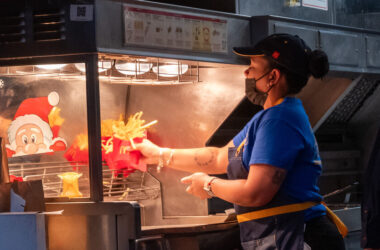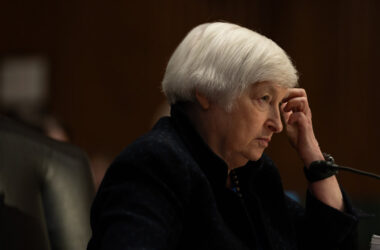“Making It Work” is a series about small-business owners striving to endure hard times.
When Egypt Otis opened her business, Comma Bookstore and Social Hub, three years ago in Flint, Mich., the pandemic was full blown. But her neighbors welcomed the literature and art she sold in her store that celebrated people of color, as well as the community programs she hosted.
Despite the warm reception, Ms. Otis quickly found that she had a sales problem: Her customers wanted to pay with their cellphones.
“I realized that people were hardly keeping a wallet or a physical card, which limited my ability to sell and make money,” Ms. Otis said. So she upgraded her transactions platform to include tap-and-go purchases on mobile devices. “People are not carrying cash,” she said. “It’s becoming obsolete.”
The number of Americans who say they are “cashless” has jumped in the last five years. Forty-one percent of Americans said they did not use cash for their purchases in a typical week in 2022, up from 29 percent in 2018, according to a Pew Research Center survey released last October.
Small-business owners increasingly are making the switch to cashless payments for several reasons, including rising consumer demand, faster checkout, lower labor costs and increased security. Those who wait risk losing revenue, experts say.
But there are drawbacks to going cash-free, including a learning curve for entrepreneurs who may not understand how to set up digital payments, a lack of accessibility to credit cards for low-income consumers, and privacy concerns.
Juanny Romero was an early adopter of digital payments for her small business. Fifteen years ago, when she founded Mothership Coffee Roasters, a chain of coffee shops in Las Vegas, she began using Square, a low-cost digital payments system for small businesses.
“I was a young businesswoman and not astute,” she said. But Square saved her $3,000 a month in merchant fees for credit card processing.
As Ms. Romero expanded her businesses (to four locations in Las Vegas, with two more on the way), she added more payment options, including Apple Pay and Google Pay.
But she noticed a shift during the pandemic: Her customers no longer wanted to use cash, and her employees did not want to handle it. “We didn’t know where Covid was coming from,” she said. “There were still people bringing in cash, but it was scary and dangerous.”
When the coin shortage hit in 2020, she ran out of cash altogether, but Ms. Romero found it saved on labor costs. “My managers were standing in line for two hours to deposit the cash,” she said. “I can’t get an armored car service to pick up $100 in cash.”
Even so, customer demand prompted her to return to cash sales, which Ms. Romero said are holding steady at about 11 percent of her overall revenue. She said she would go cashless if the share dipped below 10 percent.
The pressure to adapt is growing. More that 2.8 billion mobile wallets were in use at the end of 2020, and that is projected to increase nearly 74 percent to 4.8 billion — nearly 60 percent of the world’s population — by the end of 2025, according to a study released in 2021 by Boku, a fintech company
The United States lags other countries in adopting cashless payments. Among the most cashless countries in the world is Britain, where the pound makes up only 1 percent of all transactions, according to a report from Merchant Machine, a payment research firm based in London. But in the United States, some small-business owners do not understand the complexities of digital payments.
“Smaller merchants, they don’t always have the knowledge and resources to know what to do,” said Ginger Siegel, who leads the North America small-business segment at Mastercard, which offers training to business owners like Ms. Otis of Comma Bookstore.
Ms. Otis said she noticed an increase in sales when she began offering mobile payments, which made the checkout process faster. “As a retailer, you want to make the experience as efficient as possible,” she said. “It is a matter of survival.”
Benefits include immediate payment, increased sales and the ability to sell to customers who might use other currencies. “You have to set it up, but it’s worth it,” said Kimberley A. Eddleston, a professor of entrepreneurship at Northeastern University.
But some business owners say they are hesitant to move too quickly, worried that today’s technology could become obsolete tomorrow. And there are compatibility and cost issues to consider, said Wayne Read, the chief executive of Forged & Formed, an online jeweler with a physical store, Studio D Jewelers, in Woodstock, Ill. In his jewelry sales, where items can be pricey, he said a speedy transaction might not be suitable. “We don’t want people to feel they have rushed their decision,” he said.
Despite advances in technology, many Americans still have little or no access to financial services like credit cards and mobile wallets, although that is slowly improving. An estimated 5.9 million households did not have a bank account in 2021, down from 7.1 million households in 2019, according to a survey by the Federal Reserve.
Another obstacle to adoption is privacy concerns: Some people prefer the anonymity that cash provides. And cash is perceived as a way for consumers to remain aware of expenditures. Complicating the transition to the digital economy, the recent banking turmoil in the United States has made many depositors question the security of financial institutions.
But experts agree that cash is unlikely to go away. Consumers in lower income households continue to rely on cash for payments, according to the Fed survey.
And small-business owners say that despite the speed and efficiency that cashless payments offer, cash is still a viable option for their customers.
“At the end of the day, I know the people I serve,” Ms. Romero said. “I would feel conflicted if I didn’t do the right thing.”




